- Reaction score
- 1,332
Ok guys thought it would be a good idea to give an update about androgenetic alopecia. Basically I just want to give an insight about what the latest research is showing, but also define some basic characteristics of androgenetic alopecia (perhaps you might know allot of this) We’ll start from the beginning (skip to purple text if you don't want to read basic Androgenetic Alopecia properties
 ) ;
) ;
In the 50’s experiments were done by Dr. James Hamilton. He was also the first one who created the term “androgenetic alopecia”. He saw that men who had been castrated before puberty never went bald. Interestingly when he injected testosterone into these castrated men, some suddenly started balding but some did not. Most notably the ones with a family history of baldness started balding.
Why were his experiments so important? Well he showed that baldness is androgen dependent, because castrated men before puberty showed no signs of balding. He also showed that there is a genetic side to the story because when he injected some with testosterone, not everyone started balding. This is also why we call it “androgenetic” alopecia. Because for baldness to occur as we know it you need both androgens + genetics.
To verify this even more Imperato- McGinley studied pseudo-hermaphrodites in the Dominican republic. These pseudo-hermaphrodites were born looking like a girl with female genitals. At puberty however they virilized, developing musculature, a deeper voice and would even develop a penis some of the time. They found out that these pseudo-hermaphrodites had a deficiency of type-2 5-reductase. Then you have people who suffer from androgen insensitivity syndrome. This condition results in a partial or complete inability of cells to respond to androgens. Guess what? Well both of these type people who suffer from this condition never display androgenetic alopecia. This is again a very important observation to make that androgenetic alopecia is androgen dependent. A fun fact is that Merck developed a drug based on the study of Imperato- McGinley; finasteride a type-2 5-reductase inhibitor (5ar2) as we all know it.
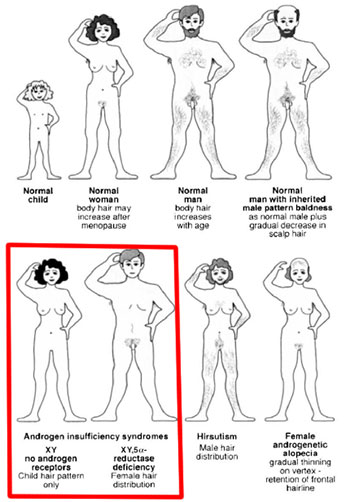
Next I want to explain hair follicle cycling in short. A hair follicle cycles as you may know. Everyone experiences this, even your norwood 1 friend. This primarily exists of the following stages; anagen, catagen and lastly telogen, this cycle repeats itself. Anagen is the active growth phase of the hair, catagen is the regression phase and telogen is the resting phase. Now look at the following picture;
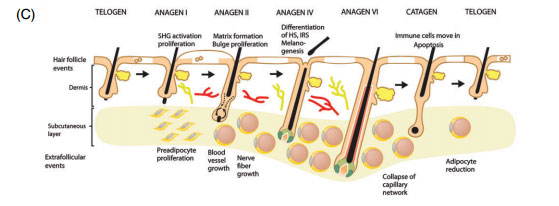
What important to know about these cycles is that the hair follicle itself, specifically the micro environment of the hair follicle is able to communicate with the macro environment (surrounding tissue) . For instance in telogen a hair will lack vascularization and blood vessels, not only that it will also lack adipose tissue. In anagen however there is a tremendous increase in vascularization and also adipose tissue. This leads to a thicker dermis in anagen, and a thinner dermis in telogen. Scalp hair follicles reside generally 80-90% in anagen, 1-2% in catagen and 10-15% in telogen.
Back to androgenetic alopecia again. You should already know that androgenetic alopecia is androgen dependent and has a genetic basis. However for androgenetic alopecia to occur these androgens need to bind to the androgen receptor in the hair follicle. Because as you know people with androgen insensitivity syndrome have hormones but they have impaired androgen receptors and they don’t bald. So where are the androgen receptors located in the hair follicle? They are solely located in the dermal papilla at the base of the hair follicle;

So in order for androgenetic alopecia to occur, androgens which are expressed in the blood need to bind to the androgen receptors located in the dermal papilla. A treatment for example like RU-58841 or CB-03 binds to the androgen receptors there and will stop androgens to attach to these androgen receptors, preventing or slowing androgenetic alopecia. There is evidence that people suffering from androgenetic alopecia have increased androgen receptor expression and increased 5ar2 expression.
In androgenetic alopecia as you guys may very well know too is that with each cycle the hair becomes more miniaturized. The hair becomes thinner, shallower and keeps reducing each cycle until you are basically left with almost nothing. Important to know is that the dermal papilla cells specify hair size, shape and the reduction of them causes a follicular decline (1), (2).
Now to the (latest) advancements about the pathology of androgenetic alopecia;
In the study named “Premature Senescence of Balding Dermal Papilla Cells In Vitro Is Associated with p16INK4a Expression”(3). They confirmed as other studies already did(4) that balding dermal papilla cells grow way slower in vitro when compared to non-balding dermal papilla cells. Not only that they found out that balding dermal papilla cells undergo premature senescence. This was associated with the following in the balding dermal papilla cells;
- Increased Expression of p16ink4a
- Increased Expression of pRb
- Expression of senescence-associated β-galactosidase
- Loss of expression of bmi-1
- Increased expression of oxidative stress and dna damage markers like HSP-27, ATM and ATR
Now a study published in November 2014 called “ Androgen Receptor Accelerates Premature Senescence of Human Dermal Papilla Cells in Association with DNA Damage” (5) found ;
- Also a increase of p16ink4a in balding dermal papilla cells and not in non-balding in vitro
- DNA damage accompanied with senescence in the balding dermal papilla cells
- Most importantly when you remove the androgen receptor from the balding dermal papilla cells DNA damage does NOT occur and senescence does NOT occur.
- The dermal papilla cells changed in morphology, they enlarged.
A other study in 2009 called “Proliferation, DNA repair and apoptosis in androgenetic alopecia (6)” found out that in comparison with occipital scalp and frontal balding scalp;
- P53 was overexpressed frontal balding scalp
- P53 showed a inverse correlation with APE-1 (dna damage repair marker)
Now you know the evidence of senescence occurring in androgenetic alopecia in the dermal papilla cells (with the accompanied factors), but also know that P53 is overexpressed in balding scalp. Soon you will know why this is such a ridiculous hard disease to treat and why reversal of androgenetic alopecia is so rare and damn difficult, but prevention is way easier.
Read the following picture this is taken from “Cellular senescence: when bad things happen to good cells(7)”. It is NON-Androgenetic Alopecia related but related to general cellular senescence;
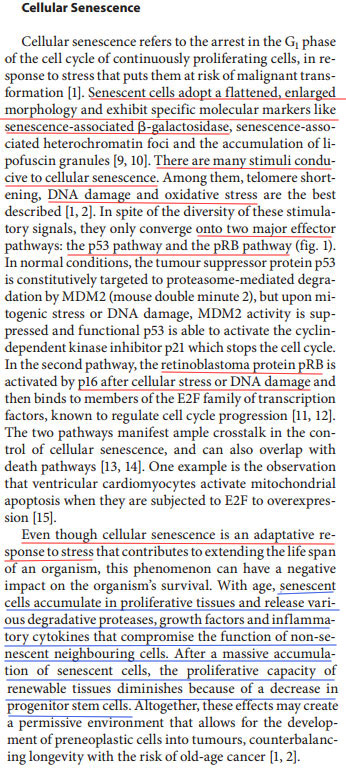
I underlined the parts in red that compare with the evidence from the androgenetic alopecia studies. P16(ink4a), pRB, P53 etc. In blue I underlined something that is very typical and extremely important for cellular senescence and that is that these cells release pro-inflammatory factors and even compromise the function of non-senescent healthy cells. Not only that note how they say that it may even lead to a decrease or even a loss in progenitor stem cells. Well as you guys know we are coping with inflammation too in androgenetic alopecia, there are a **** ton of inflammatory factors expressed. Not only that we have a lack of CD34+ and CD-200 progenitors. Even the whole morphology of the hair follicle changes. Kinda correlates huh?
So you might be asking yourself, what about DKK-1 isn’t that the cure? What about PGD2? Playing with those factors won’t cure androgenetic alopecia in my opinion. In the grand scheme of things they are relatively not important if cellular senescence occurs, which I believe is the culprit of Androgenetic Alopecia, due to fault of the dermal papilla cells. I’ll write a post later going more in-depth about this (more explanation of cell senescence ,why estrogen can work so good in reversing Androgenetic Alopecia sometimes , possible ways to tackle this problem etc.)
For now I can only say f*ck you dermal papilla cells
 . Thanks for reading.
. Thanks for reading.

1. http://www.ncbi.nlm....pubmed/23487317
2. http://www.nature.co..../5600534a.html
3. http://www.nature.co..../5701147a.html
4. http://www.ncbi.nlm.....ct&holding=npg
5. http://www.plosone.o....l.pone.0079434
6. http://www.ncbi.nlm....pubmed/18702626
7. http://www.nature.co....l/nrm2233.html
Now for the next part. What trigger can make cells go into a senescent state? What trigger can activate these pathways? Well this can be DNA damage (telomere shortening, single- and double-strand breaks), oncogenic mutations, reactive metabolites (ROS, ceramides, fatty acids, high glucose), increased mTOR activity and proteotoxic stress. As you see in the following picture (This picture most likely doesn't reflect the exact pathway in Androgenetic Alopecia which cause cellular senescence obviously but should give a global view);
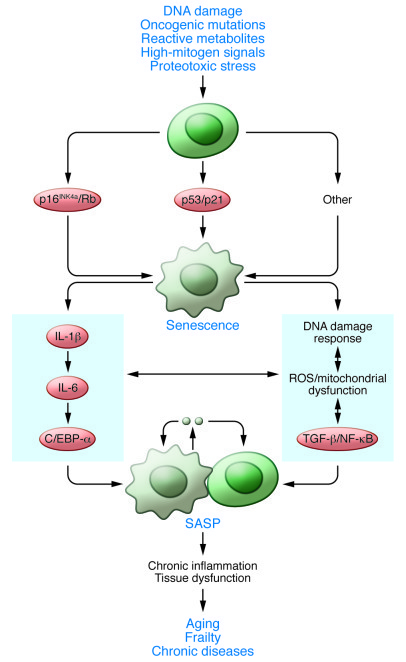
I can’t pinpoint which one is the primary reason for the dermal papilla cells to go senescent but I suppose this is primarily by DNA damage+ (ROS maybe crosstalk?) This is still a question to be answered. A interesting fact is that androgens act as DNA-damaging agents that generate DNA double-strained breaks (DSBs) which may contribute to the senescence of dermal papilla cells. A other study shows that cultured balding dermal papilla cells secrete more TGF-β (1) and this factor has been shown to stimulate oxidative stress (ROS) (2). Interestingly in normal prostate epithelial cells the androgen receptor has been shown to drive cellular senescence too but without expression of DNA damage or p16ink4a(3). So this reflects the diversity of biological responses the AR can have in relation to senescence in different cell types.
Senescence-associated secretory phenotype (SASP) as you see here in the picture above is the result of senescent cells. Senescent cells secrete pro-inflammatory factors. I quote;
“Recent evidence in fibroblasts and epithelial cells has shown that cellular senescence is accompanied by a striking increase in the secretion of 40–80 factors that participate in intercellular signaling. Secretion of this set of factors has been termed the “senescence-associated secretory phenotype”, or SASP. (Inflammatory Networks during Cellular Senescence: Causes and Consequences (4)).
Later more.
1. http://www.ncbi.nlm.nih.gov/pubmed/1...ct&holding=npg
2. http://www.ncbi.nlm.nih.gov/pubmed/8...ct&holding=npg
3. http://www.ncbi.nlm.nih.gov/pmc/arti...?report=reader
4. http://www.ncbi.nlm.nih.gov/pmc/arti...8/#!po=15.0000
It is possible that the androgen/AR-induced senescence in DPCs may not only lead to diminished DP size but also deregulate the communication between DPCs and hair follicle stem cells to differentiate to progenitor cells.
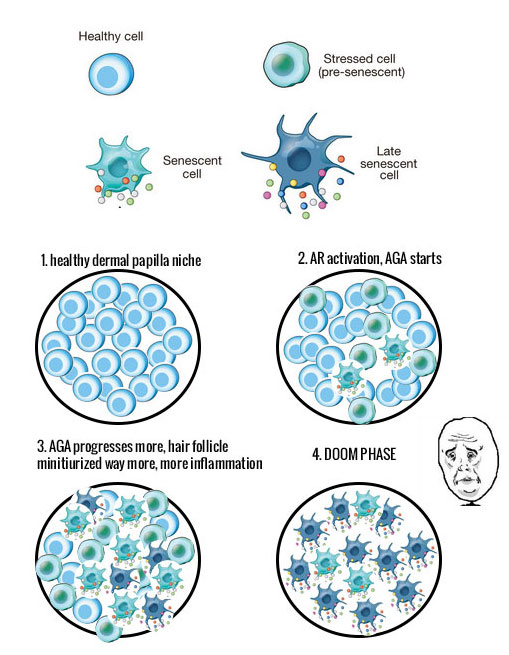
Most of us will experience some degree of hair thinning or loss as we age. In most forms of hair loss, the follicle does not disappear. Instead, it makes shorter and thinner hairs in successive cycles of hair generation until it is converted to a miniaturized “vellus” follicle that makes the tiny unpigmented hairs that remain in most “bald” scalp. The miniaturization process is progressive, with both the dermal papilla and the epithelial hair bulb diminishing in size over several hair cycles. A correlation between the number of cells in the dermal papilla and the size of the hair has been noted during hair thinning, but the question of cause and effect persisted. Does a declining epithelial population cause a `smaller dermal papilla, or does a smaller dermal papilla cause the diminution of the epithelial follicle and the hair shaft? We developed genetically modified mice that allowed us to reduce dermal papilla cell number in adult hair follicles and showed that this causes two of the hallmarks of human hair loss. Successive hair shafts produced by the same follicle are shorter and thinner, and the hair follicle spends longer periods in a quiescent phase before it starts making a new hair.
If we allowed a low level of stochastic DP cell depletion to continue, the mice failed to regenerate their hair coat, the equivalent of balding. However, the pathological cause of DP loss, inducible expression of a cell autonomous toxin specifically in DP cells, was under our control in this work. This allowed us to halt the ongoing cause of hair loss to ask whether diminished follicles were irreversibly damaged. We found that some follicles remained in the quiescent phase and did not generate a new hair. However, others continued to make new hairs and actually restored themselves, increasing the number of DP cells and generating bigger hairs in ensuing cycles. The difference between these two fates was determined by the number of DP cells that remained when the toxin was switched off. A follicle with a few more cells would generate a new hair and restore itself, while a follicle with a few less DP cells no longer contributed new hairs to the pelage.
This suggests good news for those bothered by hair loss. The threshold effect of DP cell number suggests that once the cause of DP cell loss is controlled, therapeutic approaches need only achieve modest success in restoring DP cell number to restore hair cycling. After that, the intrinsic capacity of the hair follicle to restore itself should do the rest of the job. Lest you are tempted to call, let me clearly state that we haven’t found a cure for baldness. However, this work suggests that understanding the mechanisms by which communication between the epithelial and mesenchymal compartments of the follicle regulates DP cell number may be one path to that goal.
In the broader context, this work reveals that by altering the size of the niche for an epithelial progenitor population, different gene expression and morphogenetic programs are executed by the same cell populations to dramatically alter the outcome or organogenesis. By dissecting the alterations in genetic pathways that accompany this switch, we hope to gain more general insight into the mechanisms that regulate morphogenesis.
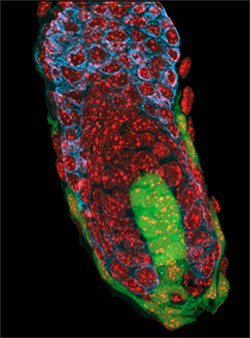
The hair follicle bulb: The dermal papilla (green cells at the center of the hair bulb) serves as both a physical and chemical niche that regulates the activity of adjacent epithelial progenitor cells (unlabelled except for a red nuclear stain) that produce the hair shaft and its surrounding inner root sheath.
In the 50’s experiments were done by Dr. James Hamilton. He was also the first one who created the term “androgenetic alopecia”. He saw that men who had been castrated before puberty never went bald. Interestingly when he injected testosterone into these castrated men, some suddenly started balding but some did not. Most notably the ones with a family history of baldness started balding.
Why were his experiments so important? Well he showed that baldness is androgen dependent, because castrated men before puberty showed no signs of balding. He also showed that there is a genetic side to the story because when he injected some with testosterone, not everyone started balding. This is also why we call it “androgenetic” alopecia. Because for baldness to occur as we know it you need both androgens + genetics.
To verify this even more Imperato- McGinley studied pseudo-hermaphrodites in the Dominican republic. These pseudo-hermaphrodites were born looking like a girl with female genitals. At puberty however they virilized, developing musculature, a deeper voice and would even develop a penis some of the time. They found out that these pseudo-hermaphrodites had a deficiency of type-2 5-reductase. Then you have people who suffer from androgen insensitivity syndrome. This condition results in a partial or complete inability of cells to respond to androgens. Guess what? Well both of these type people who suffer from this condition never display androgenetic alopecia. This is again a very important observation to make that androgenetic alopecia is androgen dependent. A fun fact is that Merck developed a drug based on the study of Imperato- McGinley; finasteride a type-2 5-reductase inhibitor (5ar2) as we all know it.

Next I want to explain hair follicle cycling in short. A hair follicle cycles as you may know. Everyone experiences this, even your norwood 1 friend. This primarily exists of the following stages; anagen, catagen and lastly telogen, this cycle repeats itself. Anagen is the active growth phase of the hair, catagen is the regression phase and telogen is the resting phase. Now look at the following picture;

What important to know about these cycles is that the hair follicle itself, specifically the micro environment of the hair follicle is able to communicate with the macro environment (surrounding tissue) . For instance in telogen a hair will lack vascularization and blood vessels, not only that it will also lack adipose tissue. In anagen however there is a tremendous increase in vascularization and also adipose tissue. This leads to a thicker dermis in anagen, and a thinner dermis in telogen. Scalp hair follicles reside generally 80-90% in anagen, 1-2% in catagen and 10-15% in telogen.
Back to androgenetic alopecia again. You should already know that androgenetic alopecia is androgen dependent and has a genetic basis. However for androgenetic alopecia to occur these androgens need to bind to the androgen receptor in the hair follicle. Because as you know people with androgen insensitivity syndrome have hormones but they have impaired androgen receptors and they don’t bald. So where are the androgen receptors located in the hair follicle? They are solely located in the dermal papilla at the base of the hair follicle;

So in order for androgenetic alopecia to occur, androgens which are expressed in the blood need to bind to the androgen receptors located in the dermal papilla. A treatment for example like RU-58841 or CB-03 binds to the androgen receptors there and will stop androgens to attach to these androgen receptors, preventing or slowing androgenetic alopecia. There is evidence that people suffering from androgenetic alopecia have increased androgen receptor expression and increased 5ar2 expression.
In androgenetic alopecia as you guys may very well know too is that with each cycle the hair becomes more miniaturized. The hair becomes thinner, shallower and keeps reducing each cycle until you are basically left with almost nothing. Important to know is that the dermal papilla cells specify hair size, shape and the reduction of them causes a follicular decline (1), (2).
Now to the (latest) advancements about the pathology of androgenetic alopecia;
In the study named “Premature Senescence of Balding Dermal Papilla Cells In Vitro Is Associated with p16INK4a Expression”(3). They confirmed as other studies already did(4) that balding dermal papilla cells grow way slower in vitro when compared to non-balding dermal papilla cells. Not only that they found out that balding dermal papilla cells undergo premature senescence. This was associated with the following in the balding dermal papilla cells;
- Increased Expression of p16ink4a
- Increased Expression of pRb
- Expression of senescence-associated β-galactosidase
- Loss of expression of bmi-1
- Increased expression of oxidative stress and dna damage markers like HSP-27, ATM and ATR
Now a study published in November 2014 called “ Androgen Receptor Accelerates Premature Senescence of Human Dermal Papilla Cells in Association with DNA Damage” (5) found ;
- Also a increase of p16ink4a in balding dermal papilla cells and not in non-balding in vitro
- DNA damage accompanied with senescence in the balding dermal papilla cells
- Most importantly when you remove the androgen receptor from the balding dermal papilla cells DNA damage does NOT occur and senescence does NOT occur.
- The dermal papilla cells changed in morphology, they enlarged.
A other study in 2009 called “Proliferation, DNA repair and apoptosis in androgenetic alopecia (6)” found out that in comparison with occipital scalp and frontal balding scalp;
- P53 was overexpressed frontal balding scalp
- P53 showed a inverse correlation with APE-1 (dna damage repair marker)
Now you know the evidence of senescence occurring in androgenetic alopecia in the dermal papilla cells (with the accompanied factors), but also know that P53 is overexpressed in balding scalp. Soon you will know why this is such a ridiculous hard disease to treat and why reversal of androgenetic alopecia is so rare and damn difficult, but prevention is way easier.
Read the following picture this is taken from “Cellular senescence: when bad things happen to good cells(7)”. It is NON-Androgenetic Alopecia related but related to general cellular senescence;

I underlined the parts in red that compare with the evidence from the androgenetic alopecia studies. P16(ink4a), pRB, P53 etc. In blue I underlined something that is very typical and extremely important for cellular senescence and that is that these cells release pro-inflammatory factors and even compromise the function of non-senescent healthy cells. Not only that note how they say that it may even lead to a decrease or even a loss in progenitor stem cells. Well as you guys know we are coping with inflammation too in androgenetic alopecia, there are a **** ton of inflammatory factors expressed. Not only that we have a lack of CD34+ and CD-200 progenitors. Even the whole morphology of the hair follicle changes. Kinda correlates huh?
So you might be asking yourself, what about DKK-1 isn’t that the cure? What about PGD2? Playing with those factors won’t cure androgenetic alopecia in my opinion. In the grand scheme of things they are relatively not important if cellular senescence occurs, which I believe is the culprit of Androgenetic Alopecia, due to fault of the dermal papilla cells. I’ll write a post later going more in-depth about this (more explanation of cell senescence ,why estrogen can work so good in reversing Androgenetic Alopecia sometimes , possible ways to tackle this problem etc.)
For now I can only say f*ck you dermal papilla cells


1. http://www.ncbi.nlm....pubmed/23487317
2. http://www.nature.co..../5600534a.html
3. http://www.nature.co..../5701147a.html
4. http://www.ncbi.nlm.....ct&holding=npg
5. http://www.plosone.o....l.pone.0079434
6. http://www.ncbi.nlm....pubmed/18702626
7. http://www.nature.co....l/nrm2233.html
Now for the next part. What trigger can make cells go into a senescent state? What trigger can activate these pathways? Well this can be DNA damage (telomere shortening, single- and double-strand breaks), oncogenic mutations, reactive metabolites (ROS, ceramides, fatty acids, high glucose), increased mTOR activity and proteotoxic stress. As you see in the following picture (This picture most likely doesn't reflect the exact pathway in Androgenetic Alopecia which cause cellular senescence obviously but should give a global view);

I can’t pinpoint which one is the primary reason for the dermal papilla cells to go senescent but I suppose this is primarily by DNA damage+ (ROS maybe crosstalk?) This is still a question to be answered. A interesting fact is that androgens act as DNA-damaging agents that generate DNA double-strained breaks (DSBs) which may contribute to the senescence of dermal papilla cells. A other study shows that cultured balding dermal papilla cells secrete more TGF-β (1) and this factor has been shown to stimulate oxidative stress (ROS) (2). Interestingly in normal prostate epithelial cells the androgen receptor has been shown to drive cellular senescence too but without expression of DNA damage or p16ink4a(3). So this reflects the diversity of biological responses the AR can have in relation to senescence in different cell types.
Senescence-associated secretory phenotype (SASP) as you see here in the picture above is the result of senescent cells. Senescent cells secrete pro-inflammatory factors. I quote;
“Recent evidence in fibroblasts and epithelial cells has shown that cellular senescence is accompanied by a striking increase in the secretion of 40–80 factors that participate in intercellular signaling. Secretion of this set of factors has been termed the “senescence-associated secretory phenotype”, or SASP. (Inflammatory Networks during Cellular Senescence: Causes and Consequences (4)).
Later more.
1. http://www.ncbi.nlm.nih.gov/pubmed/1...ct&holding=npg
2. http://www.ncbi.nlm.nih.gov/pubmed/8...ct&holding=npg
3. http://www.ncbi.nlm.nih.gov/pmc/arti...?report=reader
4. http://www.ncbi.nlm.nih.gov/pmc/arti...8/#!po=15.0000
It is possible that the androgen/AR-induced senescence in DPCs may not only lead to diminished DP size but also deregulate the communication between DPCs and hair follicle stem cells to differentiate to progenitor cells.

Most of us will experience some degree of hair thinning or loss as we age. In most forms of hair loss, the follicle does not disappear. Instead, it makes shorter and thinner hairs in successive cycles of hair generation until it is converted to a miniaturized “vellus” follicle that makes the tiny unpigmented hairs that remain in most “bald” scalp. The miniaturization process is progressive, with both the dermal papilla and the epithelial hair bulb diminishing in size over several hair cycles. A correlation between the number of cells in the dermal papilla and the size of the hair has been noted during hair thinning, but the question of cause and effect persisted. Does a declining epithelial population cause a `smaller dermal papilla, or does a smaller dermal papilla cause the diminution of the epithelial follicle and the hair shaft? We developed genetically modified mice that allowed us to reduce dermal papilla cell number in adult hair follicles and showed that this causes two of the hallmarks of human hair loss. Successive hair shafts produced by the same follicle are shorter and thinner, and the hair follicle spends longer periods in a quiescent phase before it starts making a new hair.
If we allowed a low level of stochastic DP cell depletion to continue, the mice failed to regenerate their hair coat, the equivalent of balding. However, the pathological cause of DP loss, inducible expression of a cell autonomous toxin specifically in DP cells, was under our control in this work. This allowed us to halt the ongoing cause of hair loss to ask whether diminished follicles were irreversibly damaged. We found that some follicles remained in the quiescent phase and did not generate a new hair. However, others continued to make new hairs and actually restored themselves, increasing the number of DP cells and generating bigger hairs in ensuing cycles. The difference between these two fates was determined by the number of DP cells that remained when the toxin was switched off. A follicle with a few more cells would generate a new hair and restore itself, while a follicle with a few less DP cells no longer contributed new hairs to the pelage.
This suggests good news for those bothered by hair loss. The threshold effect of DP cell number suggests that once the cause of DP cell loss is controlled, therapeutic approaches need only achieve modest success in restoring DP cell number to restore hair cycling. After that, the intrinsic capacity of the hair follicle to restore itself should do the rest of the job. Lest you are tempted to call, let me clearly state that we haven’t found a cure for baldness. However, this work suggests that understanding the mechanisms by which communication between the epithelial and mesenchymal compartments of the follicle regulates DP cell number may be one path to that goal.
In the broader context, this work reveals that by altering the size of the niche for an epithelial progenitor population, different gene expression and morphogenetic programs are executed by the same cell populations to dramatically alter the outcome or organogenesis. By dissecting the alterations in genetic pathways that accompany this switch, we hope to gain more general insight into the mechanisms that regulate morphogenesis.

The hair follicle bulb: The dermal papilla (green cells at the center of the hair bulb) serves as both a physical and chemical niche that regulates the activity of adjacent epithelial progenitor cells (unlabelled except for a red nuclear stain) that produce the hair shaft and its surrounding inner root sheath.
